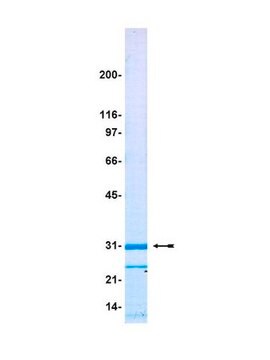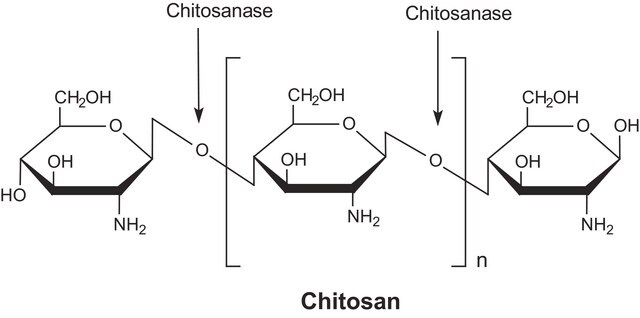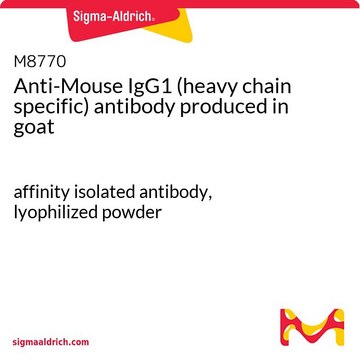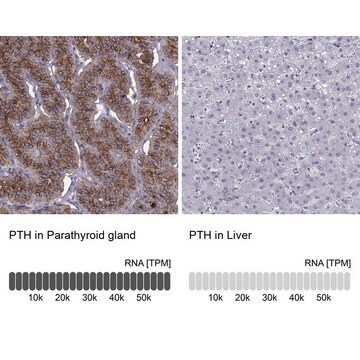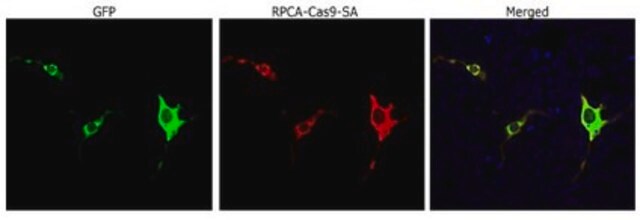17-10199
ChIPAb+ HDAC1 Antibody, rabbit polyclonal
from rabbit
About This Item
Prodotti consigliati
Origine biologica
rabbit
Livello qualitativo
Clone
polyclonal
Reattività contro le specie
human
Reattività contro le specie (prevista in base all’omologia)
hamster (based on 100% sequence homology), canine (based on 100% sequence homology), mouse (based on 100% sequence homology), rat (based on 100% sequence homology)
Produttore/marchio commerciale
ChIPAb+
Upstate®
tecniche
ChIP: suitable
immunocytochemistry: suitable
western blot: suitable
N° accesso NCBI
Condizioni di spedizione
dry ice
Descrizione generale
The ChIPAb+ HDAC1 polyclonal set includes the HDAC1 antibody, a Normal Rabbit IgG, and control primers which amplify a 88 bp region of ChIP Primers p21. The HDAC1 and negative controls are supplied in a scalable "per ChIP" reaction size and can be used to functionally validate the precipitation of HDAC1-associated chromatin.
Immunogeno
Applicazioni
Representative lot data.
Sonicated chromatin prepared from untreated or UV treated (6 hrs, 50 joules/m2.) U2OS cells (3 X 10E6 cell equivalents per IP) was subjected to chromatin immunoprecipitation using using 2 µg of either Normal Rabbit IgG, or 2 µg of Anti-HDAC1 and the Magna ChIP® A Kit (Cat. # 17-610). Successful immunoprecipitation of HDAC1 associated DNA fragments was verified by qPCR using ChIP Primers, p21 . (Figure 2). Data is presented as percent input of each IP sample relative to input chromatin for each amplicon and ChIP sample as indicated.
Please refer to the EZ-Magna ChIP A (Cat. # 17-408) or EZ-ChIP (Cat. # 17-371) protocol for experimental details.
Western Blot Analysis:
Representative lot data.
0.5 µg/mL from a representative lot detected HDAC1 in HeLa cells. (Figure 3).
Immunofluorescence Analysis:
2 µg/mL from a representative lot detected HDAC1 in HeLa cells.
Epigenetics & Nuclear Function
Histones
Confezionamento
Qualità
Representative lot data.
Sonicated chromatin prepared from U2OS cells (3 X 10E6 cell equivalents per IP) were subjected to chromatin immunoprecipitation using 2 µg of either Normal Rabbit IgG, or 2 µg of Anti-HDAC1 and the Magna ChIP® A Kit (Cat. # 17-610). Successful immunoprecipitation of HDAC1 associated DNA fragments was verified by qPCR using ChIP Primers, p21 flanking an Sp1 binding site in the human p21 promoter (Figure 1).
Please refer to the EZ-Magna ChIP A (Cat. # 17-408) or EZ-ChIP (Cat. # 17-371) protocol for experimental details.
Descrizione del bersaglio
Stato fisico
Concentration: 0.7 mg/mL
Normal Rabbit IgG. One vial containing 125 µg of rabbit IgG in 125 µL of storage buffer containing 0.05% sodium azide. Store at -20°C.
ChIP Primers p21. One vial containing 75 μL of 5 μM of each primer specific for a region of the human p21 (WAF1/CIP1/CDKN1A) promoter. Store at -20°C.
FOR: CCC ACA GCA GAG GAG AAA GAA
REV: CTG GAA ATC TCT GCC CAG ACA
Stoccaggio e stabilità
Note: Variability in freezer temperatures below -20°C may cause glycerol containing solutions to become frozen during storage.
Risultati analitici
Includes normal rabbit IgG and primers specific for human p21.
Altre note
Note legali
Esclusione di responsabilità
Codice della classe di stoccaggio
12 - Non Combustible Liquids
Punto d’infiammabilità (°F)
Not applicable
Punto d’infiammabilità (°C)
Not applicable
Certificati d'analisi (COA)
Cerca il Certificati d'analisi (COA) digitando il numero di lotto/batch corrispondente. I numeri di lotto o di batch sono stampati sull'etichetta dei prodotti dopo la parola ‘Lotto’ o ‘Batch’.
Possiedi già questo prodotto?
I documenti relativi ai prodotti acquistati recentemente sono disponibili nell’Archivio dei documenti.
Il team dei nostri ricercatori vanta grande esperienza in tutte le aree della ricerca quali Life Science, scienza dei materiali, sintesi chimica, cromatografia, discipline analitiche, ecc..
Contatta l'Assistenza Tecnica.